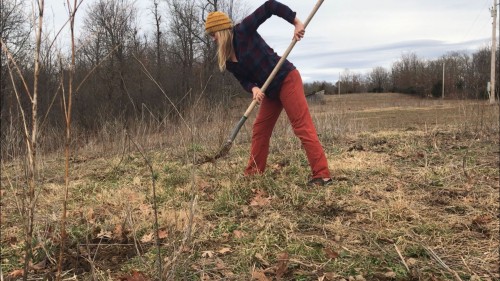
By Haleigh Smith, CYS 500RYT and Farm Manager
What has become very interesting for me as a Yoga teacher and a mover is recognizing asanas or posture among the natural, living movement that carries my body through the activities of daily life. I fold forward maybe a hundred times a day as I’m doing laundry, digging, raking, and every single time I reach for something I have dropped. I crawl, squat, kneel and move through variations of lunge in the garden and when I play with children. Side bends and twists are sprinkled throughout all foundations so that by the end of the day I have done more asanas and embodied more joint configurations than I care to tally here or anywhere.
I see my asana practice as just that– a practice. This is the sacred time and place that I designate to process and explore new patterns that become integral to the way I interface with my world. The principles and techniques of yoga are the platforms with which I assess what is happening in my body, mind, and heart so that I can honor all three with the creative reconciliation of giving them my attention. If what is learned during my practice stays only on my mat, then what exactly is it that I believe I am practicing for?
It is silly to think that I would or even could always treat posture and the many necessary transitions with as much reverence and curiosity as I do my asana practice. What I do believe is that I can practice graceful, honest movement, which is guided by breath and supported by attention. I can practice yoga off of my mat. Anywhere, in fact, and at any time. In this way, I am provided with endless opportunities to stay rooted in the awesome sensation that each moment has to offer.
Digging and Shoveling Split-Leg Stance
A handy consequence of this application of yoga is that I am able to pay homage to my body as I complete tasks that have the potential to cause wear and tear. In the photos, I am pictured shoveling, which can be very hard on the body if care is not taken to move well. In the following paragraphs, I will detail setting up this posture for use, with key factors that will begin with the feet hip-width distance apart, and then step one foot straight back, maintaining the distance between the feet widthwise as you do step. Square the hips forward. If you’re unable to do so comfortably, either increase the distance between the feet widthwise or decrease the distance between the feet lengthwise.

Once you are positioned to prioritize the hips comfortably squaring forward, ground to the outer edges of the feet and add a subtle internal spiraling action on each foot. To do this, spiral each foot inwards, towards the center line of your body without moving the foot or losing the outer edge groundedness. Keep a bend in the front knee and lengthen the legs in both directions.
Next– balance the pelvis! Lift your front hip bones so that you’re are not “spilling” your pelvic bowl forward. Now lift the rib cage and position the back of your skull over your tailbone. For most, this will mean bringing the chin in and slightly down to lengthen the back of the neck. Place your hand on your lower back to find it is slightly curved inward. Rock the pelvis back and forth until the curve exists, if it does not initially. This will be close to your neutral spine.
Keep the spine in neutral as you hinge at the hips to fold forward to your desired amount. This will require sending the pelvis through the legs, or spilling the pelvic bowl open as you tilt while keeping a slight tone in the belly. In order to check the movement of your pelvis, use a hand to feel the curve in the low back. If you have hinged at the hips to fold, the curve should feel the same as it did before you moved. In case you find that the curve has flattened, you have flexed the lumbar spine instead and this is not a healthy fold. If you find you are unable to comfortably bend forward without compromising the low back, bend the front knee more generously, widen your base or shorten your stance. Once you have found a position that is workable, hinge in and out of the fold a few times to ‘teach’ yourself this movement.
As you dig, shovel, or do whatever other activity in a stable forward fold, begin to explore the mobility of your thoracic spine (upper back), which is significantly more mobile than the lumbar spine (lower back). Twist and bend from the upper back while you keep the rest of your body set up as directed while you work. Try switching your tool from side to side as you move and don’t forget to work with the opposite leg forward as well! If you find that one position is especially challenging, this may be an interesting configuration for you, so consider spending more time in it. Make note that this configuration of actions is in motion and not expected to remain perfect. Your goal should be to accomplish these actions easily and freely so that they are integrated into your repertoire of working safe foundations.
It may seem challenging to maintain all of these actions as you work. Remember that this is a practice– an inquiry! As you breathe life into your asanas by freeing them into movement, perfection isn’t the focus. You’re invited to inquire as to how you’re moving through your life. You’re invited to give your attention to the vehicle with which you’ve been gifted to experience your surroundings. You’re invited to surrender to one of the things which are always already happening – posture.
